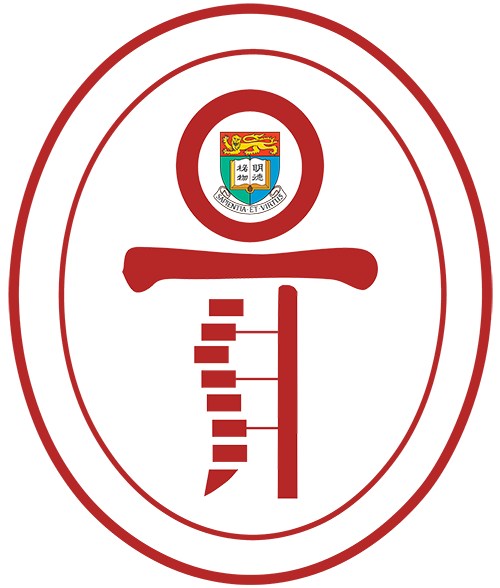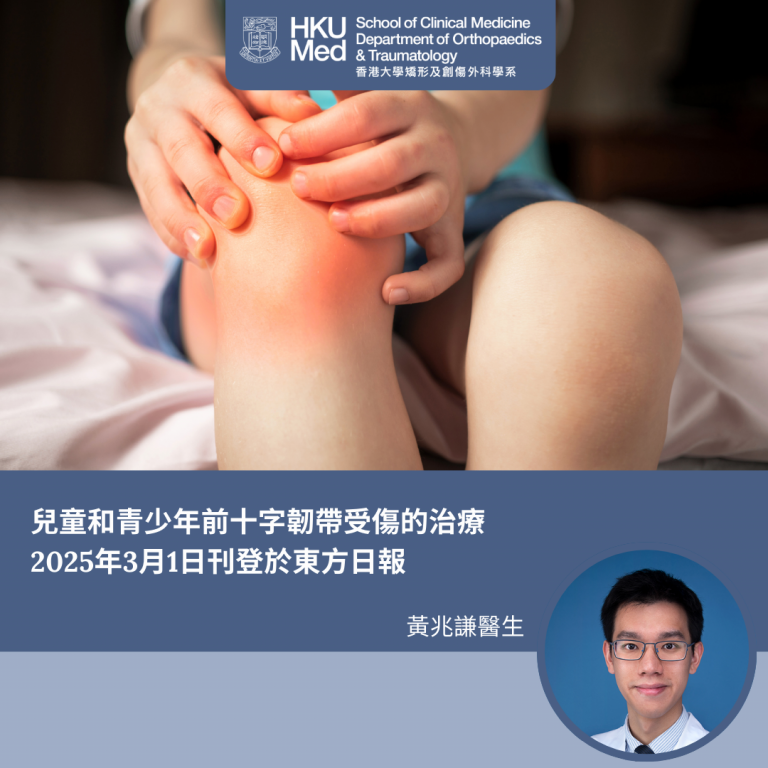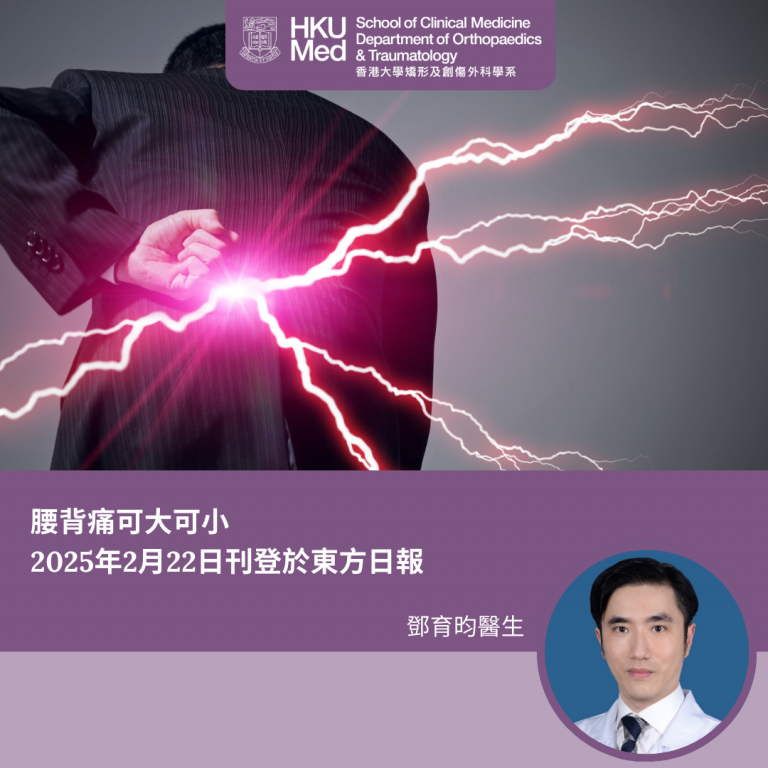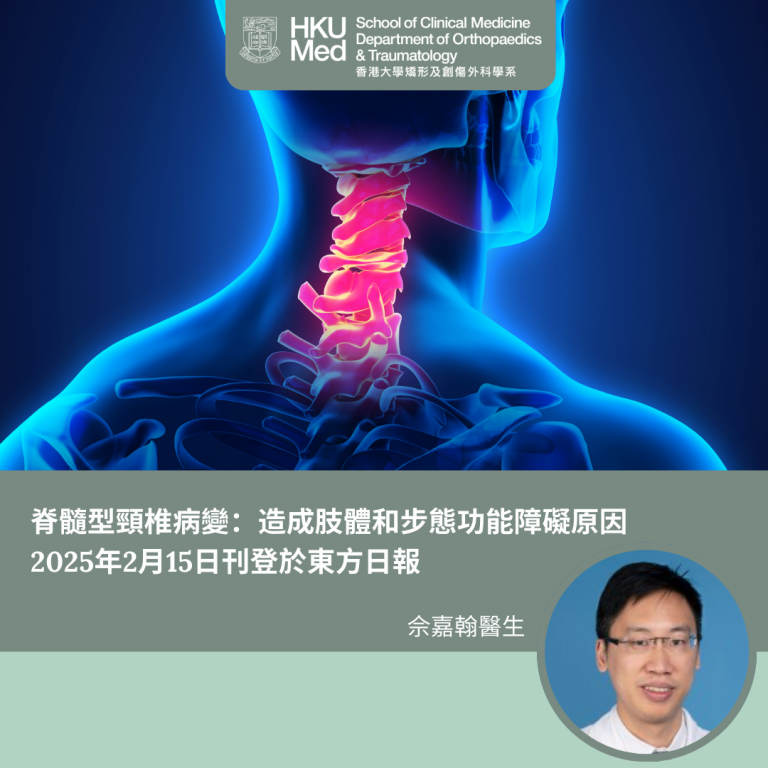HKUMed pioneers robot-assisted spine surgery in Hong Kong

29 May 2024
In a groundbreaking development, a research team from the Department of Orthopaedics and Traumatology of the School of Clinical Medicine in the LKS Faculty of Medicine of the University of Hong Kong (HKUMed) introduced robot-assisted technology in spine surgery. This is the first time this advanced approach has been used in the city to assist with guidance for instrumentation during spinal surgery.
The team has successfully performed robot-guided spinal procedures for 20 patients since October 2023. The joint-team surgeries were carried out by the Division of Spine Surgery, Department of Orthopaedics and Traumatology, School of Clinical Medicine, HKUMed, Queen Mary Hospital and Duchess of Kent Children’s Hospital. The use of robotic technology in spine surgery allows for unprecedented precision, safety and minimally invasive approaches, benefitting patients with enhanced surgical outcomes, reduced risk of complications and better revision rates.
Background
Spinal fusion surgery often requires the use of spinal instrumentation, which is particularly important in the treatment of scoliosis, a spine deformity condition that is common among children. In adult patients, instrumentation is commonly used to address issues like back pain, an unstable and/or deformed spine, or a fractured spinal column. Surgeons typically need to place screws into the deformed spine to facilitate correction and fusion of the spine. The traditional method of screw insertion into the spine uses the freehand technique, which relies on the surgeon’s anatomical knowledge, surgical experience and intraoperative X-ray checks to guide the placement. While skilled surgeons can achieve great precision with their expertise, the accuracy of screw placement has not reached 100%.
Cutting-edge robotic technology in local spine surgery
Since October 2023, 20 robotic spine surgeries have been performed with patients ranging from the teens to the 70s. One patient of note was a 72-year-old woman with degenerative kyphoscoliosis, presenting with back pain and difficulties in walking more than 10 minutes at a time. Traditionally, the surgery would be performed with freehand screw insertion, which is dependent on the surgeon’s experience. This novel technology allowed the team to utilise preoperative surgical planning software to determine the best implant strategy for optimal surgical correction. Intraoperatively, the surgery was executed according to the preoperative plan and with the assistance of the surgical robot, and the implants were inserted without stress or difficulty. Despite a lengthy surgery, it was completed smoothly and successfully.
Delivering greater precision and safer outcomes
The spine robotic system allows for preoperative planning incorporating CT images of the patient’s spine as part of the system. The surgeon plans the ideal entry point, screw size and trajectory tailored to each patient’s unique anatomy and the predicted screw alignment in the spine. During surgery, the spine robotic arm is precisely guided to the pre-planned position. The robotic guidance system also provides surgeons with real-time images of the patient’s spine, helping them achieve an unparallel level of accuracy and precision when implanting the screw. This is a significant improvement over the traditional ‘freehand’ technique, which relies heavily on the surgeon’s experience and estimates.
‘This innovative technology was introduced to public hospitals in Hong Kong in October 2023, offering local patients access to cutting-edge treatment options. The technology empowers surgeons to deliver the best possible outcomes for their patients when performing complex spinal procedures,’ said Dr Kenny Kwan Yat-hong, Clinical Associate Professor and Chief of Division of Spine Surgery, Department of Orthopaedics and Traumatology, School of Clinical Medicine, HKUMed.
‘We believe this revolutionary approach is a game-changer for local patients with scoliosis or other spinal problems, improving the accuracy and safety of instrumentation during spinal surgery, reducing the rate of revision surgery, increasing operating efficiency, reducing post-operative complications, and decreasing the length of hospital stays. We believe that there will be further applications of robotic systems in spinal surgery in the near future, resulting in shorter operation times and reduced waiting lists for spinal surgery,’ added Dr Kwan.
Professor Jason Cheung Pui-yin, Chairperson of the Department of Orthopaedics and Traumatology, School of Clinical Medicine, HKUMed, stated that the launch of this novel technology in public hospitals in Hong Kong represents a major milestone in advancing the field of spinal surgery in the city. Echoing overseas evidence and experience that have demonstrated the benefits of robot-assisted spine surgery, he explained, ‘The enhanced precision and predictability of robot-assisted spine surgery mean that we can provide our patients with safer, more effective treatments, leading to faster recovery and better long-term outcomes. We are truly excited about the transformative potential of this advanced spine robotic system and the doors it opens for our team to push the boundaries of what is possible in the world-class treatment of spinal disorders.’
About the research team
The novel robot-assisted spine surgeries were carried out by a team of surgeons from the School of Clinical Medicine at HKUMed, led by Dr Kenny Kwan Yat-hong, Clinical Associate Professor and Chief of Division of Spine Surgery; and Professor Jason Cheung Pui-yin, Clinical Professor and Chairperson, Department of Orthopaedics and Traumatology.
Related media interviews
Ming Pao Education Publications
More on
2024年05月29日
香港大學李嘉誠醫學院(港大醫學院)臨床醫學學院矯形及創傷外科學系的科研團隊,在脊椎手術上取得突破性發展,率先利用輔助機械臂進行手術,為本港首次使用這先進技術作為治療方法。
自2023年10月起,該團隊已成功使用輔助機械臂為20名患者進行脊椎手術,由港大醫學院臨床醫學學院矯形及創傷外科學系脊柱外科專家、瑪麗醫院和大口環根德公爵夫人兒童醫院團隊共同進行。在脊椎手術中使用輔助機械臂技術可以大幅提升手術的精準度、安全性和微創技術,從而改善患者的治療效果、減少併發症風險,並提高修復成功率。
背景
脊柱融合手術普遍需要在脊柱內植入固定裝置,對治療脊柱側彎等常見的兒童脊柱畸形疾病尤為重要。在成年患者中,脊柱植入手術常用於治療背痛、不穩定和/或畸形的脊柱,或脊椎骨折等問題。外科醫生一般需要將螺釘放入畸形的脊柱,以矯正和融合脊柱。傳統的脊柱螺釘植入方法靠人手操作,依賴外科醫生的解剖知識、手術經驗和手術中X光檢查以引導螺釘的植入位置。雖然熟練的外科醫生可以憑藉其專業技術達到高精準度,但螺釘擺放位置的準確性仍未達到100%。
先進機械脊椎手術創本港先河
團隊從2023年10月至今已成功完成20宗機械臂脊椎手術,患者年齡介乎十多歲至70多歲不等。其中一個病例是一名72歲患有退化性駝背脊柱側彎症的女士,她出現背痛,且每次步行難以超過十分鐘。傳統手術依賴外科醫生經驗,以人手操作植入螺釘。應用這種新技術,外科醫生利用術前手術規劃軟件來制定最佳的螺釘植入策略,以達到最佳矯正效果。這次手術在機械臂的輔助下,植釘過程沒有出現任何困難。儘管手術時間較長,但手術非常順利和成功。
手術更精準和安全
機械臂系統可以在術前計劃時,對患者脊柱進行電腦影像掃描。外科醫生根據每個患者的獨特身體結構和預測植入脊柱中的螺釘對齊,擬定理想的植入點、螺釘尺寸和植入軌跡。手術期間,機械臂會精準引導至預先計劃的位置。機械人導航系統還會為外科醫生提供患者脊柱的實時影像,幫助醫生在植入螺釘時達到極高的準繩度。與傳統單純依靠外科醫生經驗和估算的「人手操作」手術相比,這項技術對脊椎手術無疑是重大改進。
港大醫學院臨床醫學學院矯形及創傷外科學系臨床副教授兼脊柱外科部門主任關日康醫生表示:「這項創新技術於2023年10月引入香港公立醫院,為本地患者提供先進的治療選擇。這項技術賦予外科醫生在進行複雜的脊椎手術時,能為患者提供最佳的治療成效。」
關醫生補充:「我們相信,這種革命性的治療方式對於患有脊柱側彎或其他脊柱問題的本地患者來說是一大突破,不但有助提高脊椎手術中螺釘植入的準確性和安全性,降低修復手術的機率,同時提高手術效率,並減少手術後併發症和縮短住院時間。我們相信機械化系統在脊椎手術在不久將來會更廣泛應用,從而縮短手術時間及手術輪候時間。」
港大醫學院臨床醫學學院矯形及創傷外科學系系主任鍾培言教授表示,香港公立醫院引入這項嶄新技術,標誌著本港在脊柱外科領域取得重大里程碑。海外亦已有實證和經驗表明機械輔助脊椎手術的好處,鍾教授闡釋:「機械臂系統能提高手術的精準度和可預測性,讓我們可以為患者提供更安全、更有效的治療,從而加速患者的康復進度,並獲得更好的長遠治療效果。我們對這種先進的脊柱機械系統的轉化潛力感到非常興奮,並期望藉此推進我們的團隊在世界級脊柱疾病治療領域上的工作,從而開闢更多可能性,造福病人。」
關於研究團隊
這項新輔助機械臂脊椎手術由港大醫學院臨床醫學學院矯形及創傷外科學系的外科醫生團隊進行,由該學系的助理副教授兼脊柱外科主任關日康醫生,及系主任兼臨床教授鍾培言教授領導。
相關媒體報道
Ming Pao Education Publications






